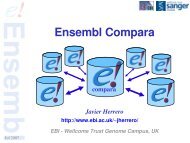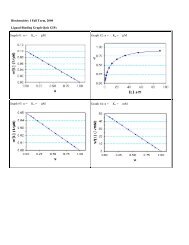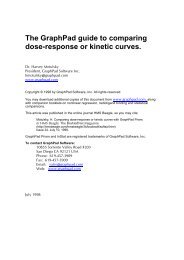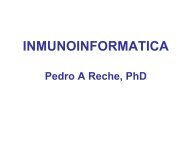Practical Course on Multiple Sequence Alignment - CNB - Protein ...
Practical Course on Multiple Sequence Alignment - CNB - Protein ...
Practical Course on Multiple Sequence Alignment - CNB - Protein ...
Create successful ePaper yourself
Turn your PDF publications into a flip-book with our unique Google optimized e-Paper software.
Sometimes it is helpful to mask parts of the query sequence to prevent them<br />
from being aligned with subject sequences. Masking is helpful when the query<br />
sequence has low-complexity regi<strong>on</strong>s, such as stretches of small hydrophobic<br />
amino acids that are comm<strong>on</strong>ly present in transmembrane helices of integral<br />
membrane proteins. Because these features arose from c<strong>on</strong>vergent evoluti<strong>on</strong>,<br />
and their inclusi<strong>on</strong> in BLAST searches could result in spurious hits, it is best<br />
to set the BLAST search parameters to eliminate these sorts of regi<strong>on</strong>s from<br />
word generati<strong>on</strong>, as well as alignment scoring.<br />
Significance of an alignment score<br />
The extend of the sequence similarity between the subject and query<br />
sequences is reported as a raw score, S<br />
in which M is the score from a substituti<strong>on</strong> matrix (e.g. BLOSUM62) for a<br />
particular pair of amino acids i and j, c is the number gaps, O is the penalty<br />
for the existence of a gap, d is the total length of the gaps, and G is the perresidue<br />
penalty for extending the gap.<br />
Obtaining a score for an alignment does not, by itself, tell you whether it is<br />
significant. One needs to determine what is the probability of observing such a<br />
score by chance, given the scoring system used and the lengths of the<br />
sequences being compared.<br />
Bit scores: Because <strong>on</strong>e has the opti<strong>on</strong> of using different parameters (e.g.<br />
scoring matrices) in different BLAST searches, it is ideal to report results in<br />
such a way as to be able to compare alignments made with different scoring<br />
matrices or gap penalties. To do this, S’ values (bit scores) are calculated.<br />
in which λ and K depend <strong>on</strong> the matrices and penalties used.<br />
E-values:<br />
If analyses were to stop here, <strong>on</strong>e would have a list of sequences sorted by bit<br />
scores that would reflect the degree of similarity to the query sequence. But<br />
how do we know if this similarity is significant, or is it <strong>on</strong>ly due to chance? (as<br />
it is the case of having a large database).<br />
To address this issue E-values are calculated from bit scores as:<br />
in which n is the total number of residues (amino or nucleic acids) in the<br />
database, and m is the length of the query sequence. E-values are the number<br />
of subject sequences that can be expected to be retrieved from the database<br />
that have a bit score equal to or greater than the <strong>on</strong>e calculated from the<br />
alignment of the query and subject sequence, based <strong>on</strong> chance al<strong>on</strong>e. E-values<br />
for subject sequences that are very similar to the query sequence will be quite<br />
small, and are widely used as a means to assess the c<strong>on</strong>fidence with which<br />
<strong>on</strong>e should claim the subject sequence sequence(s) and the query sequence as<br />
homologs.<br />
14
















